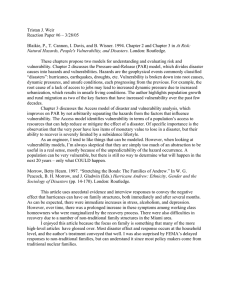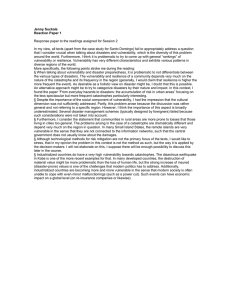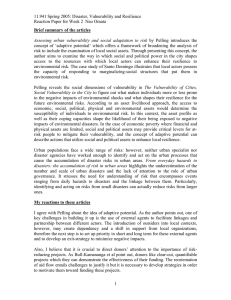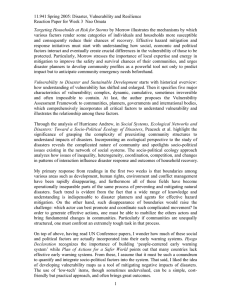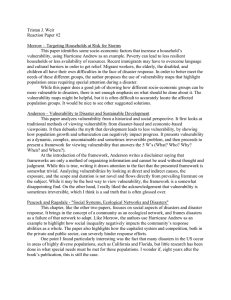Disasters and Social Vulnerability: Insights From Theory and Research Kathleen Tierney
advertisement
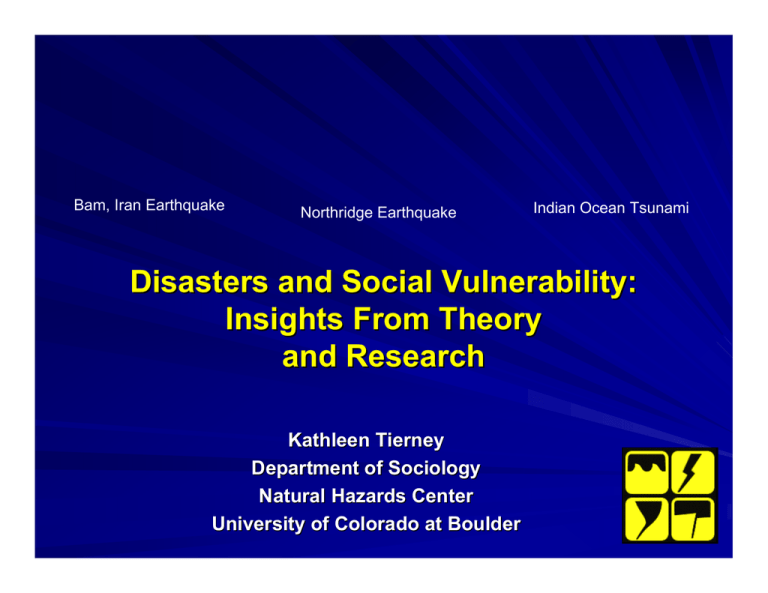
Bam, Iran Earthquake Northridge Earthquake Indian Ocean Tsunami Disasters and Social Vulnerability: Insights From Theory and Research Kathleen Tierney Department of Sociology Natural Hazards Center University of Colorado at Boulder Presentation Themes Theoretical Framework for the Analysis of Social Vulnerability Ways of Conceptualizing Vulnerability Contributors to Vulnerability What is a Disaster? Disasters as Distinguished From…. Hazards Chronic or Long-Term Environmental Hazards Slow-Onset Events Epidemics “Dissensus” Crises Affecting Communities, Societies: Riots, Communal Violence War Mass Migrations, Humanitarian Crises Contrasting Paradigms Classical or Systems Perspective Vulnerability Perspective Systems-Oriented Perspective: Defining Disaster Charles Fritz (1961): “An event, concentrated in time and space, in which a society, or a relatively self-sufficient subdivision of a society, undergoes severe danger and incurs such losses to its members and physical appurtanances that the social structure is disrupted and the fulfillment of all or some of the essential functions of the society is prevented.” Assumptions of the Systems Approach Societies and Communities are Systems, Organized Around Essential Social Functions Disasters Constitute Crises for Social Systems, Forcing Social Units (Households, Organizations, etc.) to Adapt Disasters Originate in the Environment and Impinge Upon Social Systems Shortcomings of the Systems Perspective Event-Focused, Rather Than Process-Focused: Characterizes Disasters as Beginning at Time of Impact Neglect of Diversity of Subunits Within Societies, Communities, Possibility of Differential Impacts, Differing Perspectives Rooted in Functionalist Assumptions that Characterized U. S. Sociology in 1950s, 60s Vulnerability Paradigm Sees Causes of Disasters as Internal to the Social Order, Not External Sees Disasters as Experienced Differently by Different Social Units, Groups Within Communities and Societies Sees Society Not as an Integrated “System,” but Rather as Characterized by Inequality and the Potential for Conflict Vulnerability Paradigm: Key Assumptions Disasters and Disaster Impacts are Socially Produced Vulnerability Linked to Larger-Scale Societal Factors and Processes and Their Interaction With Disasters Groups Within Society are Differentially Vulnerable to Disasters The Progression of Vulnerability 1 2 3 ROOT CAUSES DYNAMIC PRESSURES UNSAFE CONDITIONS Fragile physical environment • Dangerous locations • Unprotected buildings and infrastructure Limited access to • Power • Structures • Resources Ideologies • Political systems • Economic systems Lack of • Local institutions • Training • Appropriate skills • Local investments • Local markets • Press freedom • Ethical standards in public life Macro-forces • Rapid population growth • Rapid urbanisation • Arms expenditure • Debt repayment schedules • Deforestation • Decline in soil productivity Fragile local economy • Livelihoods at risk • Low income levels Vulnerable society • Special groups at risk • Lack of local institutions DISASTER HAZARDS Earthquake RISK = Hazard + Vulnerability R=H+V Public actions • Lack of disaster preparedness • Prevalence of endemic disease Source: At Risk: Natural Hazards, People’s Vulnerability, and Disasters by P. Blaikie, T. Cannon, I. Davis, and B. Wisner High winds (cyclone/ hurricane/ typhoon) Flooding Volcanic eruption Landslide Drought Virus and pests Contributors to Vulnerability “Hazardousness of Place” Vulnerable Built Environment, Ecosystems Socially Structured “Event” and “Consequence” Vulnerability The Built Environment: Bam Earthquake: Vulnerability of Traditional Adobe Construction 1 Social relations and flows of surplus 2a Households Individudals in Production Unit 1 (e.g. ‘household’) 4 Structures of domination 2b Their resource and assets with assets, e.g., land, labour, capital, tools, expectations of resources from others 3a Income opportunities each face a range of income opportunities Individuals in Production Unit 2 Individuals in Production Unit 3 Individuals in Production Unit n 9 Outcome of decisions changes in access profile at a later time 5 Choices of household each household chooses one or (usually) more income opportunities (often a number of times a year) together termed household access profile and individual access profile 8 Decisions decisions taken on consumption, investment, and realization of assets 3b Access qualifications each income opportunity has access qualifications and a pay-off (money, yields of crop, etc.) 7 Household budget livelihoods contribute to household budget which is in deficit or surplus at different times of the year 6 Livelihood together, chosen income opportunities may constitute a livelihood Births, deaths, and demographic changes in time period Source: At Risk: Natural Hazards, People’s Vulnerability, and Disasters by P. Blaikie, T. Cannon, I. Davis, and B. Wisner Joseph Henry Press “Second Assessment” Series American Hazardscapes. Susan L. Cutter, ed. (2001) Paying the Price. Howard Kunreuther and Richard J. Roth, Sr., eds. (1998) Disasters by Design. Dennis Mileti. (1999) Facing the Unexpected. Kathleen J. Tierney, Michael K. Lindell, and Ronald W. Perry. (2001) Cooperating with Nature. Raymond J. Burby, ed. (1998) Event and Consequence Vulnerability Who Prepares? Who Suffers Disproportionate Losses? Who is More Resilient, Able to Recover? VULNERABILITY RELATED TO… Income and Educational Levels Minority Group Status, Gender, Language Barriers, Citizenship Status “Social Capital” and Access to Resources Natural Hazards Research and Applications Information Center University of Colorado 482 UCB Boulder, CO 80309-0482 Web: www.colorado.edu/hazards
